First Stop: Mendoza - Malbec Country
For Diane and I, the trip to Argentina had been in the making since 2019, but then COVID hit and we had to abandon plans for the time being. It wasn't until 2022 that we could make the trip, albeit with an abbreviated itinerary. And not by ourselves. Our friends, the Thunens, John and Linda had been to Argentina before, but not to Mendoza and Iguaçu Falls. They wanted in.
After a long set of flights from SLO to Dallas, then from DFW to Buenos Aires, then a drive from the B.A. Int'l airport to the national one, and from there to Mendoza, the four of us finally arrived in Mendoza, dead tired. We checked into the Raices Aconcagua, a nice and friendly hotel, but a one that had seen more glamorous days.
When our tour agent met us in Buenos Aires to drive us to the national airport, she informed us about a curious currency exchange situation. With about 60% inflation in the country, the people and businesses want the American dollar (and Euro). She told us that the official exchange rate is 106 pesos to the dollar - that's if you go to a bank or charge a purchase on your credit card.
But if you send yourself money through Western Union from a debit/credit card, they give you an exchange rate nearly double that - about 190 pesos to the dollar (called the "Blue Dollar" rate). She also mentioned that if we had dollars, we often could get the same rate by asking to pay in dollars at restaurants or wineries. As you can imagine, this trick really made things very affordable.
Linda, Diane, George and John at Los Carolinos, a wonderful, little restaurant that was near our hotel. We ate there several times. Our favorite dish was their quinoa salad.
Mendoza has many parks, several that take up entire city blocks. This fountain, in Plaza Independencia, was commemorating the local red wines, particularly of course, Malbec.
Mendoza has wide streets with lots of leafy trees. The trees are irrigated through an open canal system (acequias) that runs throughout the city.
We had three tours scheduled while in Mendoza - a visit to three wineries in the Luján de Cuyo area of Mendoza, a bus trip into the Andes and lastly, a visit to three other wineries in Valle de Uco (Uco Valley).
Our first winery was Bodega Vistalba, that was founded in 2003 by Carlos Pulenta. They make sparkling wines, Malbec, Pinot Noir, Cabernet Savignon, Chardonnay and several other varietals.
The tasting room and sales area of Bodega Vistalba.
They fermented most reds in these cement tanks. They often have to make small repairs to tanks because of earthquake damage.
Not to be confused with Vistalba, the next winery we visited was Alta Vista. This winery offered a splendid outdoor seating area to sample their wines. We also were given a tour of their extensive cave where they aged their wines.
The last winery we visited that day was Clos de Chacras. The winery has a beautiful outside sitting area next to a small pond where we had an exquisite lunch paired with their delicious wines. I could have spent the night!
The appetizer consisted of raw salmon in a sauce with nuts and onion. The main course was a rack of lamb.
One of our stops was to see the highest peak in Argentina - Aconcagua. It is the highest mountain in the Americas at 22,837 feet. It also happens to be the highest mountain in the southern hemisphere.
Near the Chilean border, our van made a left turn up a windy, dusty mountain road. We followed it up for several miles, ending up at the statue of Christ de Redeemer. We were at 12,650 feet elevation. It was windy and very chilly. Walking around was effort.
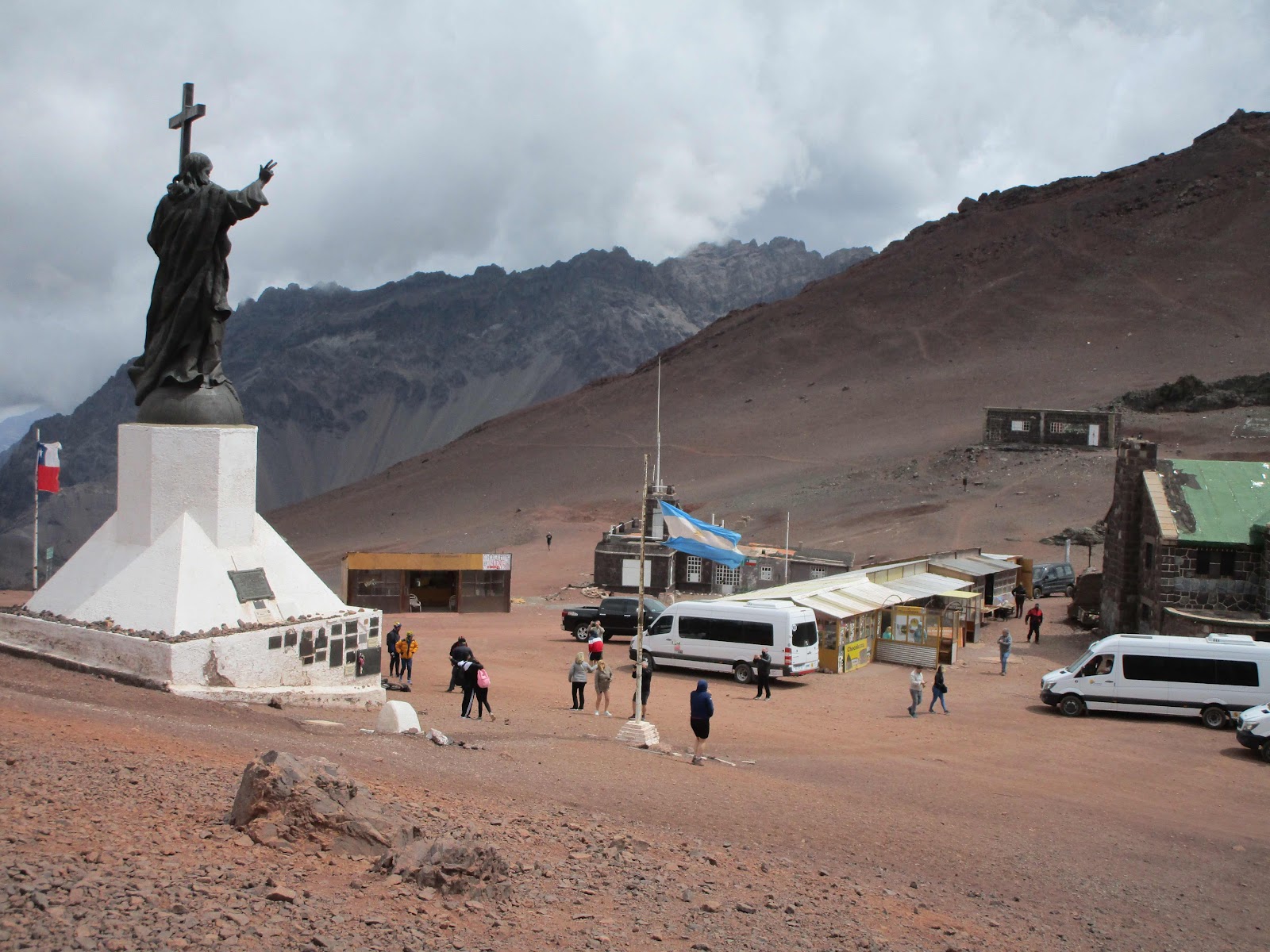

On our return, we first stopped to have lunch at the desolate mountain village of Uspallata. After a tasty lunch we visited Puente del Inca (above), a natural rock bridge with hot springs flowing into the Vacas River. (The bacteria and algae from the hot springs cause the colorful effect on the rocks.)
Visible in the photo above is a small church. Next to it is what remains of a hotel that used to be there until a rock slide demolished it - but the church survived untouched. Adjacent to Puente del Inca, is a small community of people who live there and offer native wares for sale.

After our excursion to the Andes, the following day was another full day of wine tasting and a lunch pairing. This time we drove south of Mendoza to Valle de Uco (Uco Valley). Our first winery was Masi, near the town of Tupungato. It offered beautiful views of the Tupungato Volcano (yes, those are the snow-caped Andes in the background, not clouds).







The last winery we visited in Valle de Uco was Andeluna. It was there that we had another lunch pairing with their wines. Our table came with grand views of the vineyards and the mountains. Their wines were good as was their food, but after having the Domaine Bousquet wines, they didn't quite measure up to our elevated palette.

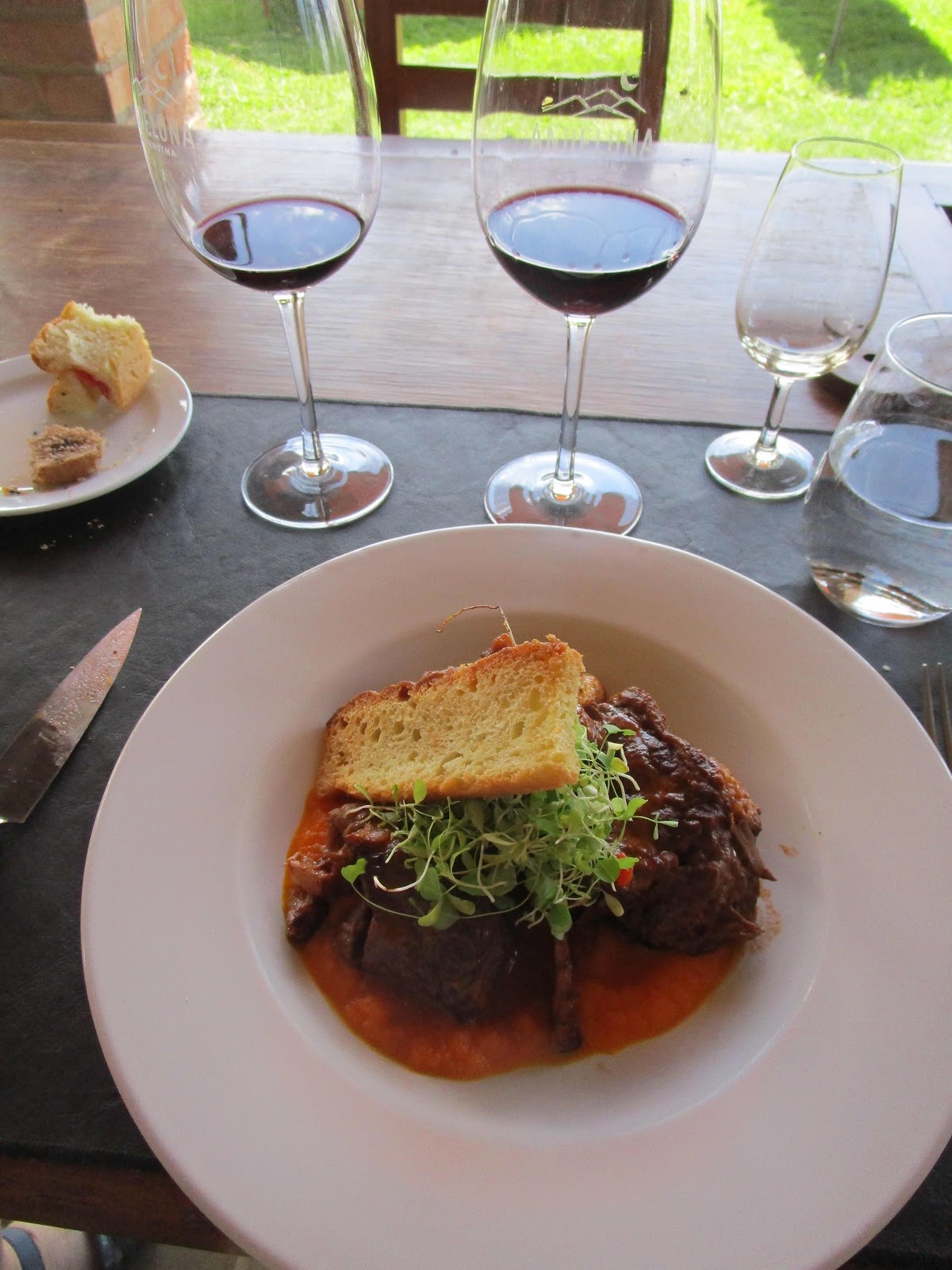


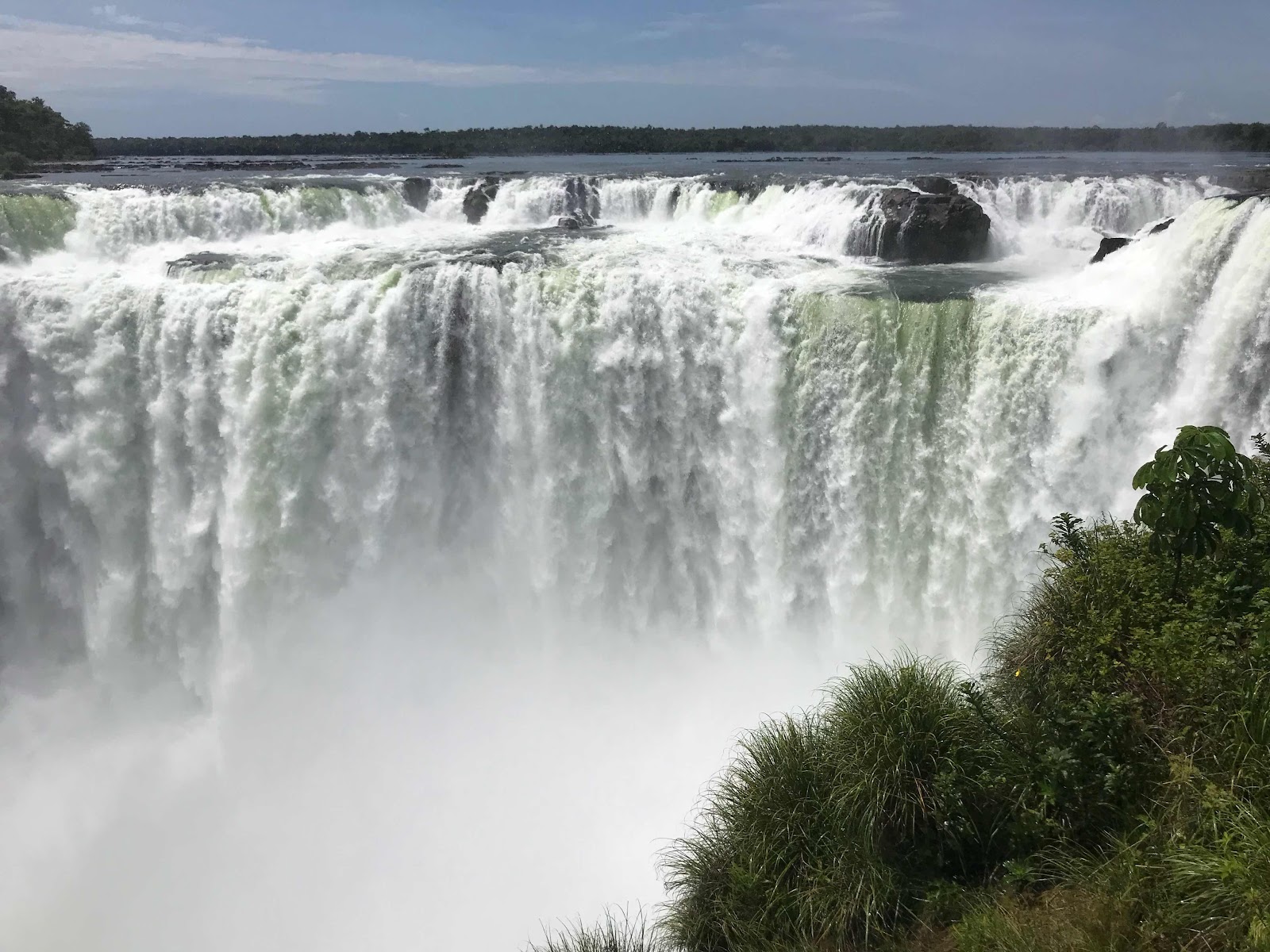

On the following day we went on our scheduled tour to view the falls from the Brazilian side. Due to COVID and border crossing restrictions, this was a messy and time-consuming process. We had to have all kinds of paper work ready such as attestation forms, declarations, exit papers for Argentina, entry papers for Brazil and then the same papers for the return trip. Border crossings took about an hour each way.
From the Brazilian side we saw these magnificent views.

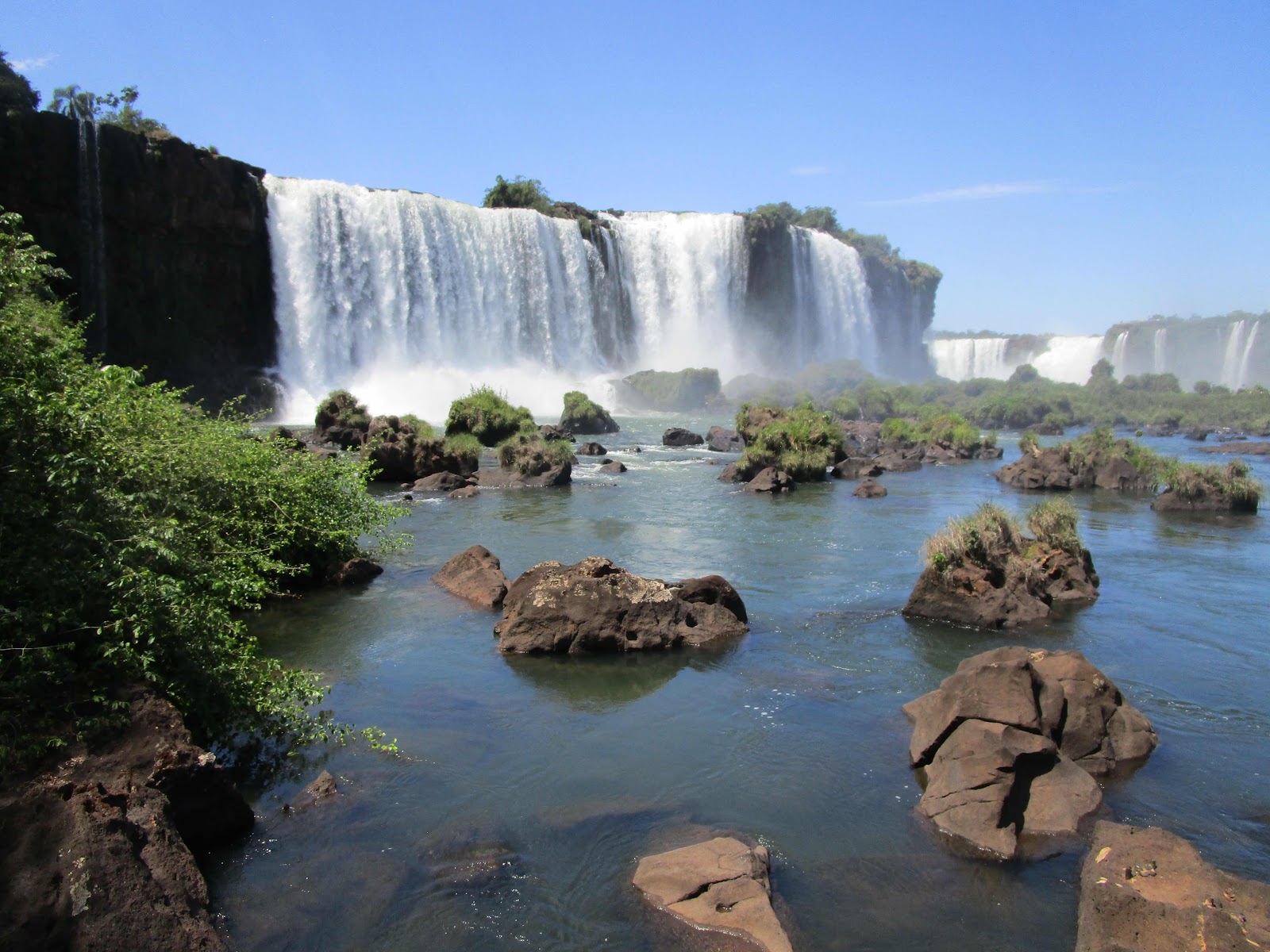







The view from our hotel room on the 7th floor.
After our excursion to the Andes, the following day was another full day of wine tasting and a lunch pairing. This time we drove south of Mendoza to Valle de Uco (Uco Valley). Our first winery was Masi, near the town of Tupungato. It offered beautiful views of the Tupungato Volcano (yes, those are the snow-caped Andes in the background, not clouds).
As in many of the Mendoza wineries, they too used concrete tanks to ferment their red wines.
Masi Winery uses an Italian wine making technique known as appassimento for drying harvested grapes in bamboo racks. These grapes are dried for about three weeks then added to other, just picked grapes, to ferment together. The process, apparently yields higher sugars and more intense flavors.
The ambiance of Masi's tasting room was serious and professional. The wines were superb as was the tasting.
Domaine Bousquet was probably our favorite winery. An organic winery, Domaine Bousquet makes wines with organically grown grapes and no added chemicals. They produce wines under several labels. We tasted several of their wines, all excellent. But my favorite was the Gran Malbec (below).
The Domain Bousquet tasting room.
A delicious slow-cooked beef dish was the main course.
A last view of one of the tree-lined streets in Mendoza. Note the open canal on the left.
From Mendoza, we flew back to Buenos Aires and from there caught another flight to Iguaçu Falls. With a slight flight delay and the fact that we were picked up with several other travelers, by the time we got to our hotel, it was late and we were exhausted. It had been a long, long day.
Some points of interest - the Iguaçu Falls are the largest falls in the world. They can be seen from the Argentinian side as well as the Brazilian side. From the Argentinian side one sees the falls from up above. From the Brazilian side, one sees the falls from down below. We were there to see the falls from both countries.
Our first day we went to see them from the Argentinian side. Instead of going with the tour that headed out at 7:30am, we opted to have the hotel call us a taxi to take us to the park's entry - a superb decision on Diane's part because we were able to sleep in and have a leisurely breakfast.
We walked several kilometers on two different paths to view the main falls and other, smaller ones. The temperature was in the high 80's to low 90's accompanied with hefty humidity.
On the following day we went on our scheduled tour to view the falls from the Brazilian side. Due to COVID and border crossing restrictions, this was a messy and time-consuming process. We had to have all kinds of paper work ready such as attestation forms, declarations, exit papers for Argentina, entry papers for Brazil and then the same papers for the return trip. Border crossings took about an hour each way.
From the Brazilian side we saw these magnificent views.
The (above) type of animal was all around the falls, looking for a handout. They are similar to raccoons but are called coatis. They are a bit aggressive if you've got food but otherwise very friendly and ready for a back scratch.
A spectacular sunset from the rooftop of our hotel (the O2) when a squall approached.
The view from our hotel room on the 7th floor.
From Iguaçu Falls we flew back to Buenos Aires, where we were greeted by Patricia, our tour operator guide. We settled into our hotel, a Novotel in the heart of the city. Patricia had recommended a restaurant nearby, the Chiquilin. We decided to give it a try. We walked to the restaurant around 7:30pm without reservations. Going to a restaurant without reservation early in the evening is not a problem because most Argentinians eat dinner after 9pm. We had a delightful dinner and were able to pay in dollars at twice the official rate - needless to say, the dinner was a bargain and a success.
Photo of restaurant ---------------------------------------------------
In the morning Patricia picked us up and gave us the grand tour of Buenos Aires and some of its history. We saw the obelisk, Tortoni Cafe (the oldest cafe in Argentina - circa 1858), the opera house, the Santelmo flea market, we visited the Caminito district and the Recoleta neighborhood which had the famous Recoleta cemetery.
The cemetery is similar to Paris' Père Lachaise Cemetery in that the mausoleums can be quite imposing and that the individuals buried there were the luminaries of Argentina - including the grave of Eva Peron. By the way, they buried her body five meters below the surface in a fortified crypt to discourage any grave diggers.
The Metropolitan Cathedral, where Pope Francis gave his sermons before assuming office at the Vatican in 2013.
This area is dedicated to those who have lost their lives due to COVID.
Above was sad reminder of all the missing persons (mostly young people, at the time) who were arrested and never heard from again during the reign of the military junta - this all happened with the support of the U.S. government during Gerald Ford's presidency and Secretary of State Henry Kissinger aiding and abetting this ruthless junta. The mothers of the missing wore white scarves, and in this plaza, white scarves are painted on the ground in remembrance of their children. Still today, women still come on Thursday evenings wearing white scarves and stand in the plaza.
On the city tour we visited the San Telmo flea market and the Caminito district, that are in the barrios area of the city - not all that safe except for the area they showed us.
There's an abundance of tango music and tango dancing in Argentina. We went to one of the tango shows near the obelisk that we thoroughly enjoyed. But often, one would see street performers performing tango dances too.
We learned about the history of the tango. Apparently, it started with prostitutes in the brothels of Buenos Aires (since no proper woman would participate in such sexual dancing!). In time, the dance eventually made its way to the elite circles and later became synonymous with Argentina.
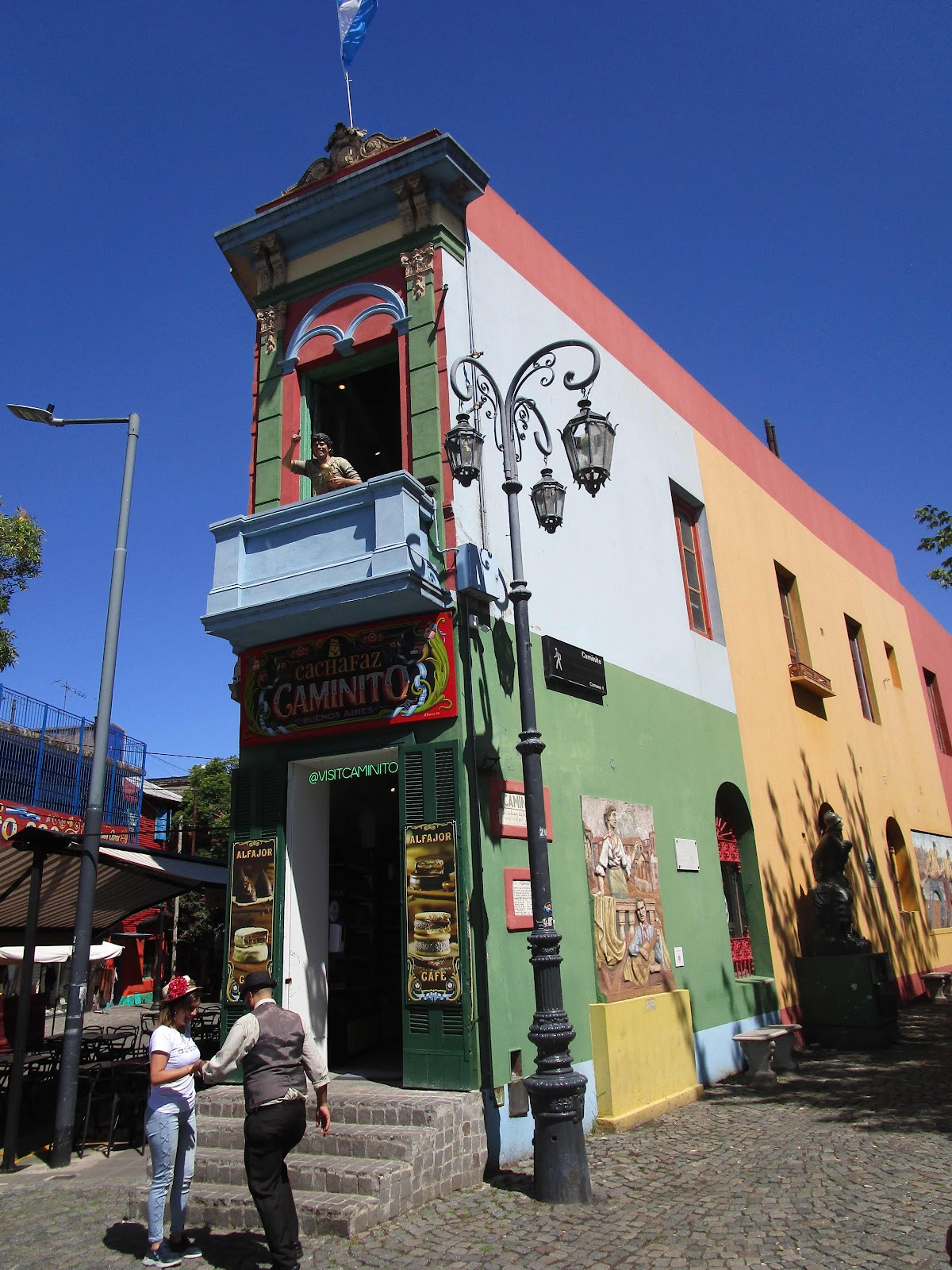

Our tour guide, Patricia, brought us to our last stop of the tour - the Recoleta Cemetery. Similarities to the famed Paris Père Lachaise Cemetery abounded. The Recoleta Cemetery is smaller and less conspicuous but none-the-less it houses impressive Argentinian elites such as Eva Peron in majestic-looking crypts.
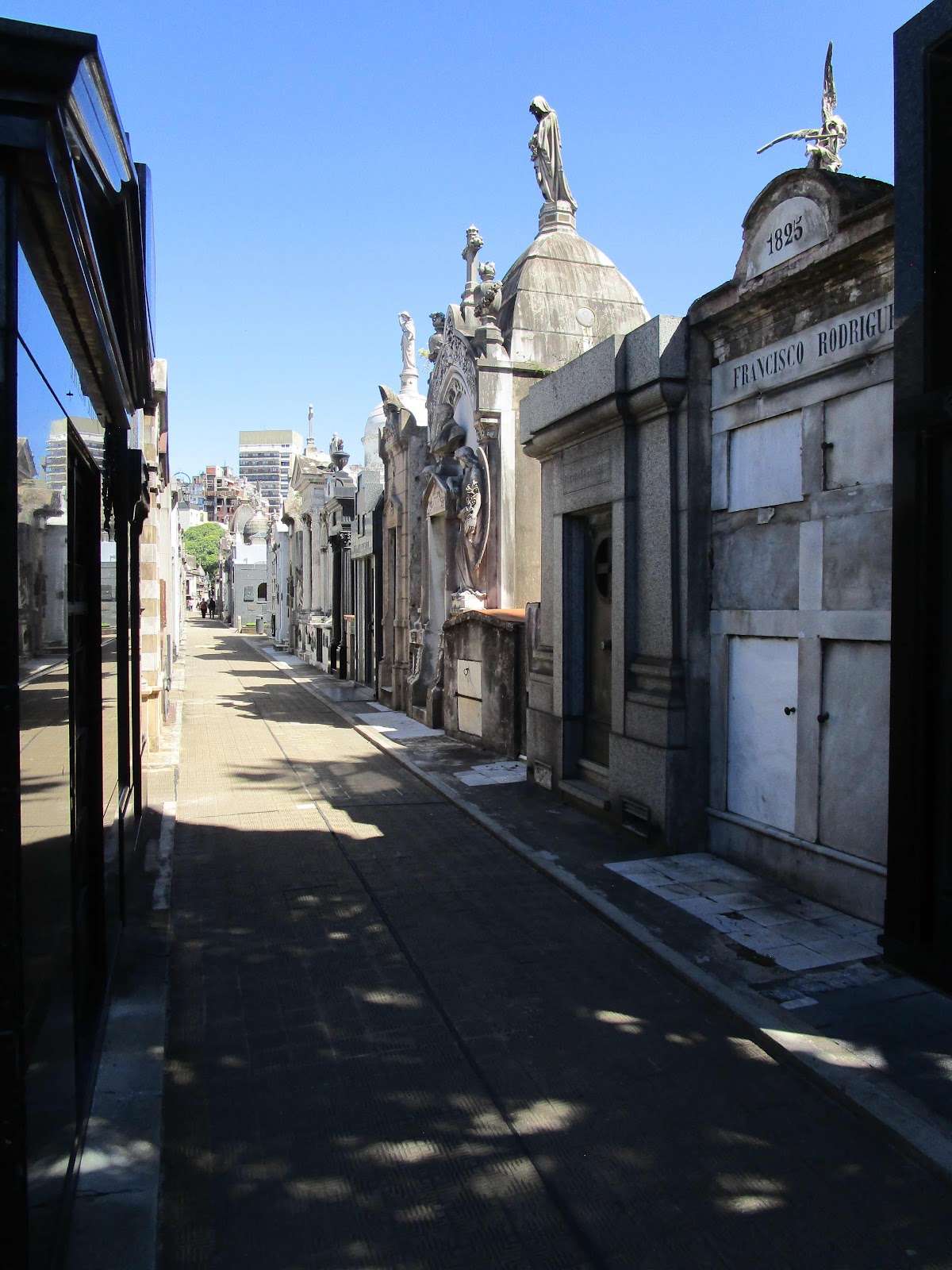

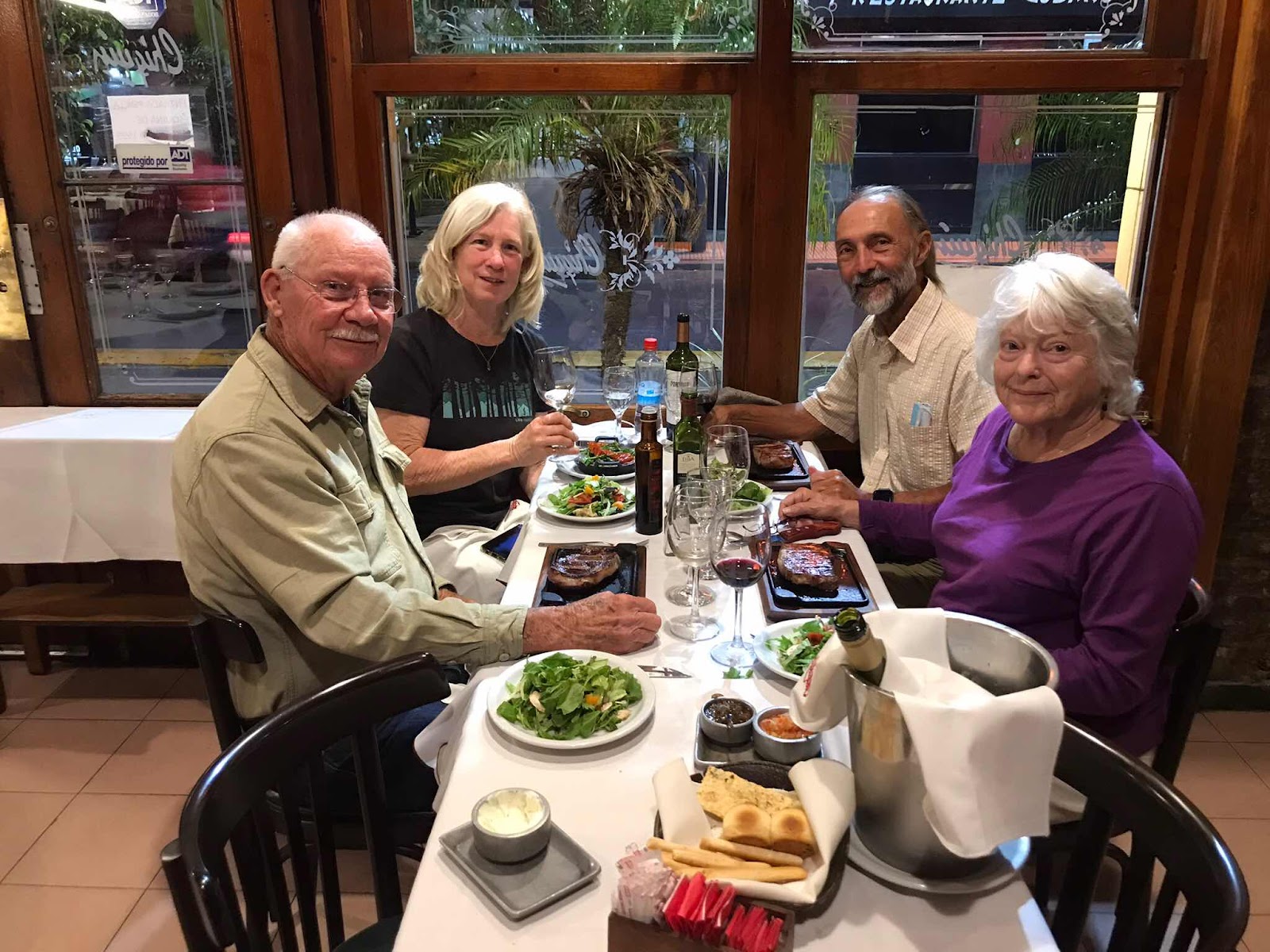
On one of our last days in Buenos Aires, we got on a boat tour that took us to the town of Tigre. I had envisioned a more meatier tour, but all we saw from the boat were some houses on stilts and docks. At the end of the two hour boat ride we arrived in Tigre - a touristy town with restaurants and home furnishings stores - an odd set of combinations. They gave us 25 minutes to walk around - just enough to meander up the street and back but not enough time to eat lunch or even have a beer.
Our tour guide, Patricia, brought us to our last stop of the tour - the Recoleta Cemetery. Similarities to the famed Paris Père Lachaise Cemetery abounded. The Recoleta Cemetery is smaller and less conspicuous but none-the-less it houses impressive Argentinian elites such as Eva Peron in majestic-looking crypts.
Above is Eva Peron's crypt. She's buried five meters below in a heavily fortified crypt.
The Chiquilin restaurant near our Novotel Hotel was one of our favorites. Great food, good wines, good service and they gave us an excellent exchange rate on our dollars. Needless to say, a perfect match.
On one of our last days in Buenos Aires, we got on a boat tour that took us to the town of Tigre. I had envisioned a more meatier tour, but all we saw from the boat were some houses on stilts and docks. At the end of the two hour boat ride we arrived in Tigre - a touristy town with restaurants and home furnishings stores - an odd set of combinations. They gave us 25 minutes to walk around - just enough to meander up the street and back but not enough time to eat lunch or even have a beer.
Tigre also is known for having casinos (illegal in B.A.) and for having the largest amusement park in South America. Totally weird.
Fortunately, we didn't have to suffer through another lengthy boat ride to get back. There was a small bus waiting to take us back to B.A. Such a relief. We came away from the tour wishing we had gone on a wine tasting tour, a visit to a museum or just stayed at the hotel and read a book.
On one of our free days, we toured the Japanese Gardens. It's in the heart of Buenos Aires, with lots of big, busy streets surrounding it.
The Japanese Gardens - small but beautiful.
Within 1.5 km from our hotel was the Botanical Gardens. It was significantly larger than the Japanese Gardens and thus quieter.
The obelisk in Buenos Aires is located on one of the widest streets in the world - 16 lanes at its widest. Built in 1936, it was built to commemorate the city's 400th birthday.
Some businesses really like to set themselves apart through wild colored paint.
One of Buenos Aires' main thoroughfares through the city, I counted nine lanes (plus parking) on this one-way street in the city.
The final part of a trip during these strange COVID times is the agonizing and stressful time to test oneself to be able to return to the U.S. Both the Thunens and we brought self-testing antigen kits that we could do in the privacy of our hotel rooms. Above, Diane is starting a proctor-lead test in our hotel room. Our results were negative. The Thunens weren't as fortunate - Linda tested positive. John tested positive a few days later. As a result, they had to remain in Buenos Aires several days longer. Not an optimal way to end a trip, but those are today's risks in traveling outside of the U.S.

